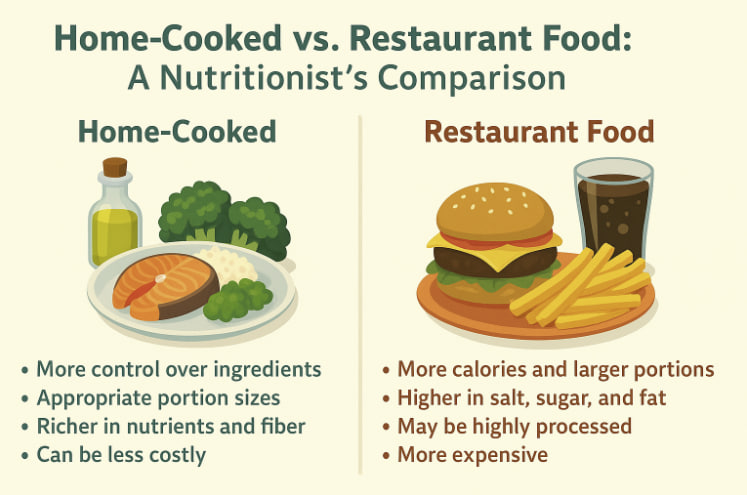In an era of fast-paced lifestyles and food delivery apps, many people wonder: is eating out really worse than eating at home? From a nutritional standpoint, the difference between home-cooked and restaurant meals can be significant. While both options have their place, they vary greatly in terms of calories, portion size, salt, fat, additives, and even emotional impact.
Let’s explore the pros and cons of each from the perspective of nutritional science.
Nutritional Control and Ingredient Quality
Home-Cooked Meals:
- You control the type and amount of fat, sugar, and salt used.
- You can choose whole, unprocessed ingredients and avoid hidden additives.
- Easier to adapt meals to special diets: low-sodium, gluten-free, diabetic-friendly, etc.
Restaurant Meals:
- Often use more salt, sugar, and saturated fat for flavor enhancement.
- Ingredients may be pre-processed or reheated, especially in chain restaurants.
- Limited control over portion size and preparation methods.
Winner: Home cooking — more transparency and control over what you eat.
Calories and Portion Size
Restaurant Portions:
- Usually larger than necessary, especially in fast food or casual dining chains.
- Often include high-calorie sauces, fried sides, and sugary drinks.
- Dessert portions can exceed 1,000 calories.
Home Portions:
- Easier to control with standard kitchen tools and mindful habits.
- You’re less likely to serve ultra-caloric appetizers and desserts by default.
Winner: Home cooking — better portion control and calorie awareness.
Nutrient Density
Home Meals:
- More likely to include vegetables, whole grains, and legumes.
- Balanced plates are easier to prepare consciously.
- Meals can be tailored to include healthy fats and lean proteins.
Restaurant Meals:
- Often rich in refined carbs (white rice, pasta, bread) and low in fiber.
- High levels of sodium and unhealthy oils in frying or grilling processes.
- Limited vegetable portions unless specifically ordered.
Winner: Home cooking — usually richer in vitamins, fiber, and healthy nutrients.
Cost and Emotional Impact
- Home cooking is cheaper in the long term, especially for families.
- Involving family members or partners in cooking improves social bonding and eating habits.
- Restaurants offer convenience and social experiences, but not always the healthiest food.
From a mental health perspective, balanced home meals tend to encourage mindful eating, while restaurant meals are often rushed, mindless, or overly indulgent.
When Eating Out Is Okay
- Choose grilled or baked options instead of fried.
- Ask for sauce on the side, reduce portion sizes, and skip sugary drinks.
- Look for restaurants with nutrition labels or wholesome menu options.
- Don’t treat restaurant meals as “cheat days” — they should still be part of a healthy lifestyle.
Glossary
- Portion size — The amount of food served in one sitting.
- Nutrient-dense — Foods rich in vitamins and minerals relative to their calorie content.
- Processed foods — Items altered with additives, preservatives, or flavor enhancers.
- Mindful eating — Paying full attention to the food experience to avoid overeating.
- Sodium — A mineral found in salt that affects blood pressure and heart health.


